I went on Nishikamaone(West Sickle Ridge) this day. A long rocky trail all over the tree line along the ridge running from Northwest to southeast. Could have seen alpine flowers around if it were in summer. Could have seen splendid Mt.of Spear ahead if it were sunny.
Departed Col of Sugoroku at 8 am. It was late. The night before weather forecast told the weather became better in the afternoon. I believed it. But it turned out wrong. later I regretted I hadn't started earier.
L) Mt.Mitsumatarenge - Washiba Pass (Mitsumata Lodge can seen) - Mt.jii (over Washiba pass) - Mt.Washiba
R) Sugoroku Hut and Sugoroku Pond

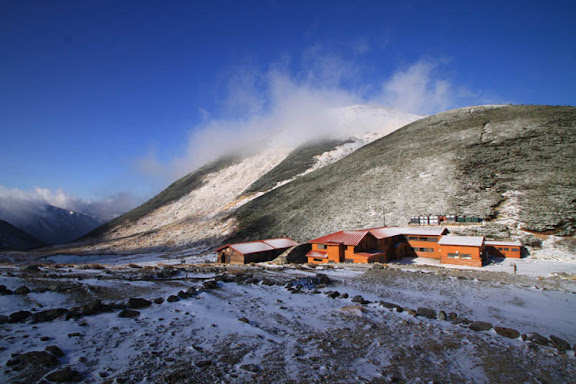
Walked up to Mt.Momisawa. Mt.of Kasa barely can be seen - Col of Sugoroku to Mt.Washiba
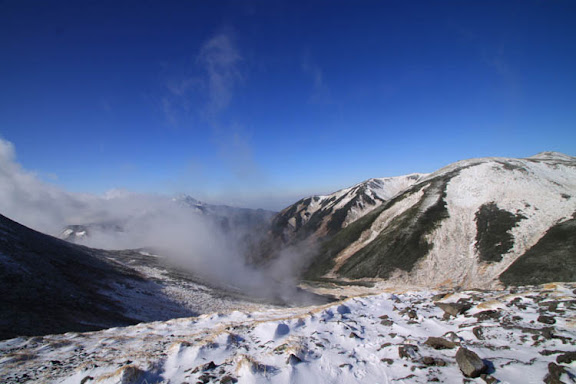

What animal? Large footprints - Into the cloud - Mt.Momisawa peak

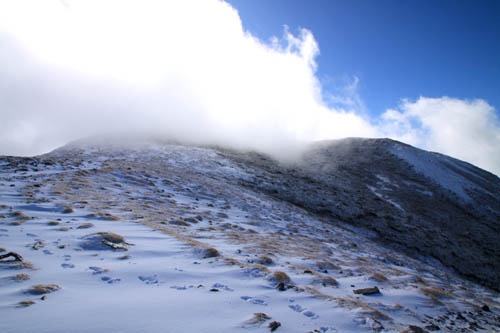
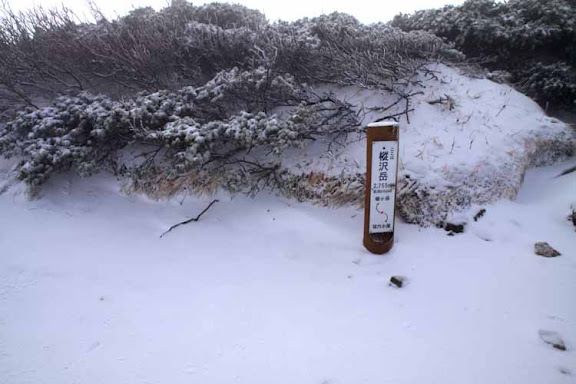
After Mt.Momisawa, I took off crampons. In bright white cloud, sometimes small hailstones hit on me. The wind blew strong and chunk of clouds kept coming from south to north. Mt. of Yari sometimes appeared for several seconds and soon the next cloud hid it.R) Sugoroku Hut and Sugoroku Pond


Walked up to Mt.Momisawa. Mt.of Kasa barely can be seen - Col of Sugoroku to Mt.Washiba


What animal? Large footprints - Into the cloud - Mt.Momisawa peak



Iou Pass. The trail was on the north side of the ridge and sheltered from the wind. A bit of sunshine came. The last view of the sun of that day. And the last view of Mt.of Yari.
From Nishikama Ridge to Mt.of Yari, it could be a spectacle to walk along the rocky narrow ridge line, if it were sunny. Always could see the grand body of Yari, almost seemed like a vertical wall, precipitous valleys down below. The Altitude was about 2600 m. Over the tree line. But short Creeping pine trees were blocking the wind in spots. Near Iou Ridge, rocks were orange. I smelt something like sulfur. At the foot of Iou Ridge, volcanic gas is released in several places and the vegetation is destroyed. Hot springs are there too.
Near Senjouzawa Pass, there was the most thrilling place of Nishikama Ridge. Almost a rock climbing route for me. Of course I would have died if I fell. Actually it's not so dangerous though, only if you are not an accrophobe. They installed chains at the most difficult places. Then I saw chains continued up and down as far as I could see. Since it was foggy, I didn't see how long it was.
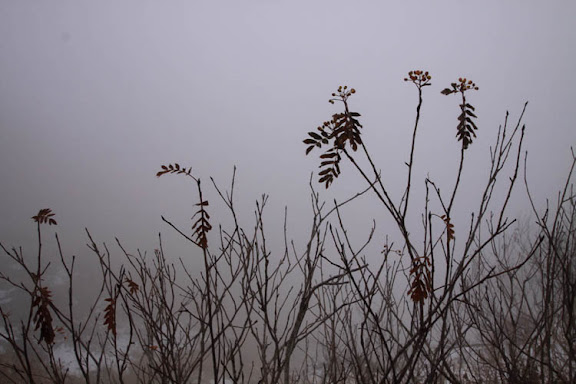 Just before getting Senjouzawa Pass, I took the last long break. Foggy. Couldn't see distance. The trail had 3 cm snow deep. The wind was blocked by the ridge on the right-hand. But I was hearing the sound of wind overhead. After the pass, the trail was completely open to the wind from Southweat. I was walking up to Mt.of Yari from its west side. Vertically about 400 m. The standard course time was 1.5 hrs. It was 2 pm. I thought I must be able to arrive to Yarigatake Lodge within 3 hours at longest, even though I was carrying a heavy backpack and slow. I was just concerning if I could pitch my tent before dark.
Just before getting Senjouzawa Pass, I took the last long break. Foggy. Couldn't see distance. The trail had 3 cm snow deep. The wind was blocked by the ridge on the right-hand. But I was hearing the sound of wind overhead. After the pass, the trail was completely open to the wind from Southweat. I was walking up to Mt.of Yari from its west side. Vertically about 400 m. The standard course time was 1.5 hrs. It was 2 pm. I thought I must be able to arrive to Yarigatake Lodge within 3 hours at longest, even though I was carrying a heavy backpack and slow. I was just concerning if I could pitch my tent before dark. In just a several dozen meters ahead, snow depth became more than 30 cm. Had a bad feeling. And it turned out worse than expectation. In some places, drifting snow was more than 60 cm. I sank in snow and stuck soon.
By the way, There is a foreign origin Japanese word "rasseru" which probably most Japanese know include those who aren't interested in mountains. It means "To walk ahead pushing through fresh snow to make a trace". I had been curious about the origin of this word and searched it the other day. It seemed nobody know the exact answer. But the most plausible hypothesis was that came from Savoyard "Faire la seulle" (make/do the trace). Japanese says "rasseru suru"(do rasseru) and it exactly means "to make a trace (on fresh snow)". I agree with the hypothesis.
Anyway, I had to do "la seull" for all the way rest. Gee! What a hard job! Raise your foot high and step on the snow wall in front of you. The leg sinks up to the thigh. Raise the other foot high and step. It also sinks up to the thigh. Repeating it several times makes a relatively solid snow floor which you can step on with your both feet. Then repeat the same movement again and again.
I gave up soon. I'm not such a strong alpinist. I'm not a man - sometimes I marvel at those men who walk up steep hills easily carrying large backpacks. They steadily step up and soon disappear. I sigh. Nothing can be done about it. Praise their physical gift, praise their training and go back to work.
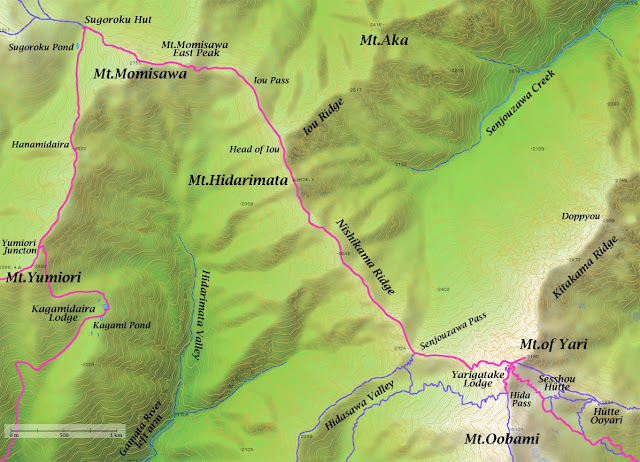 The present problem at the time was my scarce muscle power and endurance to "la seull".
I doubted I could arrive to the hut by the sunset. My speed was so slow. I was carrying my backpack packed for a 2-week hike. It must be over 20 kg at the time.
The present problem at the time was my scarce muscle power and endurance to "la seull".
I doubted I could arrive to the hut by the sunset. My speed was so slow. I was carrying my backpack packed for a 2-week hike. It must be over 20 kg at the time. As a matter of fact, there was a trace on the snow. It was still new. Somebody, who must had departed from Sugoroku Hut earlier than me, was ahead. A man, with no crampon, with a single stick. Actually I was following his footprints from the beginning. I had been wondering what kind of person he was. A reckless beginner who didn't bring any winter gear? A veteran who had climbed snowy mountains many times and didn't feel like putting on crampons? Maybe the latter. He straightly went on the trail and patiently kept la-seull-ing in the deep snow, being buried up to the chest sometimes. Wow, he was strong! But unfortunately his trace wasn't so helpful for me. The snow wasn't hardened enough in the trace which made by a single light-weight hiker.
I got off the trail, cos the snow was the deepest on the trail, and started walking on the trail shoulder. It was dangerous. Snow was shallow but the rocks and pebbles there were unstable. They easily broke down and many times I almost fell. I imagined if I slip, slide and fell. The slope was steep but probably I shouldn't fall till the bottom of the valley. The fallen snow was soft and had friction. Even though it likely I got injured somewhere. If I break or even sprain my ankle, I couldn't walk anymore and need to bivouac on the middle of the steep slope. There was no Large rock, no hollow, no bush and the snowfall was too shallow to make a shelter.
I held my ice ax in my uphill hand, a trekking pole in the other hand. Fragile rocks and snow which start to break as soon as I step on. I was saying to myself in my mind. "Slow but steadily. If I fall I will die." Wind were blowing as ever. Snow flakes were hitting on my right side. Poor visibility as ever. I couldn't see how far I came and how far more I had to climb. Just the altimeter told me I was progressing little by little. I continuously put caramels and candies in my mouth and ate energy bars every short break. I was afraid of being worn out. Water in the hydration tube started to freeze. Bad news. My gloves were wet. Bad news. Then finally it passed 5 o'clock and was getting dark. Very bad.
I thought about bivouac seriously but there didn't seem a good place as ever. And I came already higher than 2900 m. A good news was The temperature was not so low, I guess minus 1 or 2 degree. Comparing to mid winter, it was rather warm. The snow was not so heavy, the wind was not so strong, comparing to a storm. And I wasn't so tired. At least I felt so. Lit the headlamp, I kept walking, slowly, step by step, panting .
In the twilight, huge rocks hanging above faintly appeared. The altitude was almost 3000 m. I knew the last 100 m always seemed never finish. My progress slowed down. The altitude affected. I must be very close to the peak. But couldn't see anything but flying snow flakes in the darkness.
My antecessor seemed to have lost his way for a while. The trail became very indistinguishable around there. There was a short branch trace stopped about 10 m ahead. He turned back and kept going for several doezen meters to the right direction. Then I lost his trace. The wind had erased it. I was still on the trail at least. Since there was a wooden pole stuck on the slope. It was thin, half burried and almost covered with rime ice. I couldn't see the next pole though.
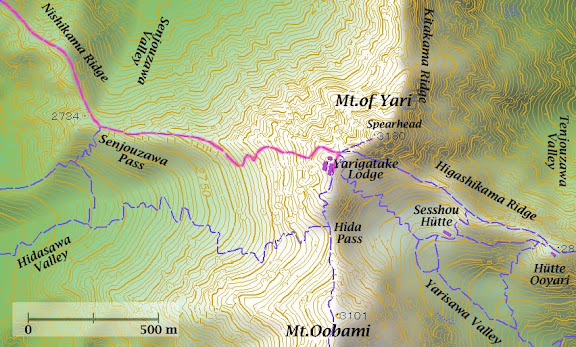 I took the backpack off and sat down. It was the third or fourth short break. Suddenly the cloud around me was blown out. Snowfall almost stopped. Stars between the higher clouds! I stood up and looked around. I could see the silhouette of the mountain. But I was confused. It looked like there were two peaks ahead. And my route seemed to go between them. Due east. Right direction at least. But I wondered if there was a col. And also I wondered why there was no light of Yarigatake Lodge at all. Snow started again. I searched for the clue like crazy. Then found something like a small hut on the skyline of the right "peak". That must be a part of the lodge. Outdoor toilet? Or a shed? Soon the snow became harder and hided everything again. I still wasn't sure where exactly I was. But started walking toward the "col". As I went, the slope became gentle and finally became flat. I found I was standing at the foot of Spearhead; the pointy rock peak of Mt.of Yari. I was at "the shoulder of Spear". The right hand, I finally saw the lights of Yarigatake Lodge. It was built on the east face of the small peak. Well sheltered from the west wind. It was a very large mountain hut which had many windows casting light but all of them were facing East.
I took the backpack off and sat down. It was the third or fourth short break. Suddenly the cloud around me was blown out. Snowfall almost stopped. Stars between the higher clouds! I stood up and looked around. I could see the silhouette of the mountain. But I was confused. It looked like there were two peaks ahead. And my route seemed to go between them. Due east. Right direction at least. But I wondered if there was a col. And also I wondered why there was no light of Yarigatake Lodge at all. Snow started again. I searched for the clue like crazy. Then found something like a small hut on the skyline of the right "peak". That must be a part of the lodge. Outdoor toilet? Or a shed? Soon the snow became harder and hided everything again. I still wasn't sure where exactly I was. But started walking toward the "col". As I went, the slope became gentle and finally became flat. I found I was standing at the foot of Spearhead; the pointy rock peak of Mt.of Yari. I was at "the shoulder of Spear". The right hand, I finally saw the lights of Yarigatake Lodge. It was built on the east face of the small peak. Well sheltered from the west wind. It was a very large mountain hut which had many windows casting light but all of them were facing East.It was about 6 pm when I arrived to the lodge. Definitely late. I had given up to camp already before I enter the front door. I didn't feel like staying at the campsite in snow. Checked in the Lodge.
I worked hard to have things done before the lights-out. Other guests were about 10. They had finished dinner already and relaxed at the saloon. An old gentleman saw me and surprised. (Cos I arrived so late? Maybe he was worrying me but didn't expect I would stay at the Lodge.) I recognized him too. I didn't know he was there. He was staying at Sugoroku Hut the day before and knew I was going to Mt.of Yari. He talked to me in the corridor.
 As I thought, he was the person whose trace I followed all the way. He left Sugoroku Hut about 7 am and walked smoothly till Senjouzawa Pass then came across the deep snow. He said he spent for 3 hours to climb up that last part. I told him I needed 4 hours.
The other man joined us and said he came on Higashikama Ridge, where the east side of the mountain. Snow was also deep there. Higashikama Ridge had a rough part in highr altitude than Nishikama Ridge. He said he staked his life on his 4-point crampons and it was so scary. He regretted he didn't bring his 10 or 12-point crampons. Then they said there were many people who didn't bring crampons and retreated from Sesshou Hütte.
As I thought, he was the person whose trace I followed all the way. He left Sugoroku Hut about 7 am and walked smoothly till Senjouzawa Pass then came across the deep snow. He said he spent for 3 hours to climb up that last part. I told him I needed 4 hours.
The other man joined us and said he came on Higashikama Ridge, where the east side of the mountain. Snow was also deep there. Higashikama Ridge had a rough part in highr altitude than Nishikama Ridge. He said he staked his life on his 4-point crampons and it was so scary. He regretted he didn't bring his 10 or 12-point crampons. Then they said there were many people who didn't bring crampons and retreated from Sesshou Hütte.In autumn, anybody can't decide easily what they should bring to mountains. Once it snow, it will turn into dangerous winter. But if it's sunny, the sunshine will make you sweat and you can enjoy hiking feeling comfortable autumn breeze. You might a bit regret you are carrying heavy winter equipments. But probably you think it's better than the opposite case.
The wind was moaning outside. By chatting each other, we were celebrating being in a cozy wooden lodge at 3060 m elevation, where everybody have to walk by their own feet to reach. And enjoyed a modest sense of accomplishment from what we did at the day.



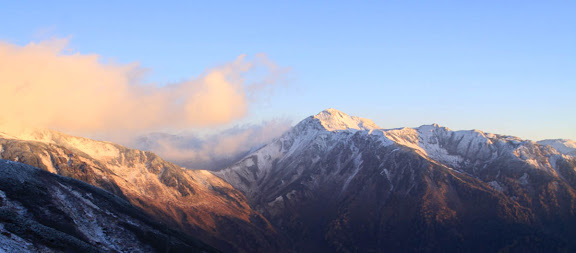


No comments:
Post a Comment